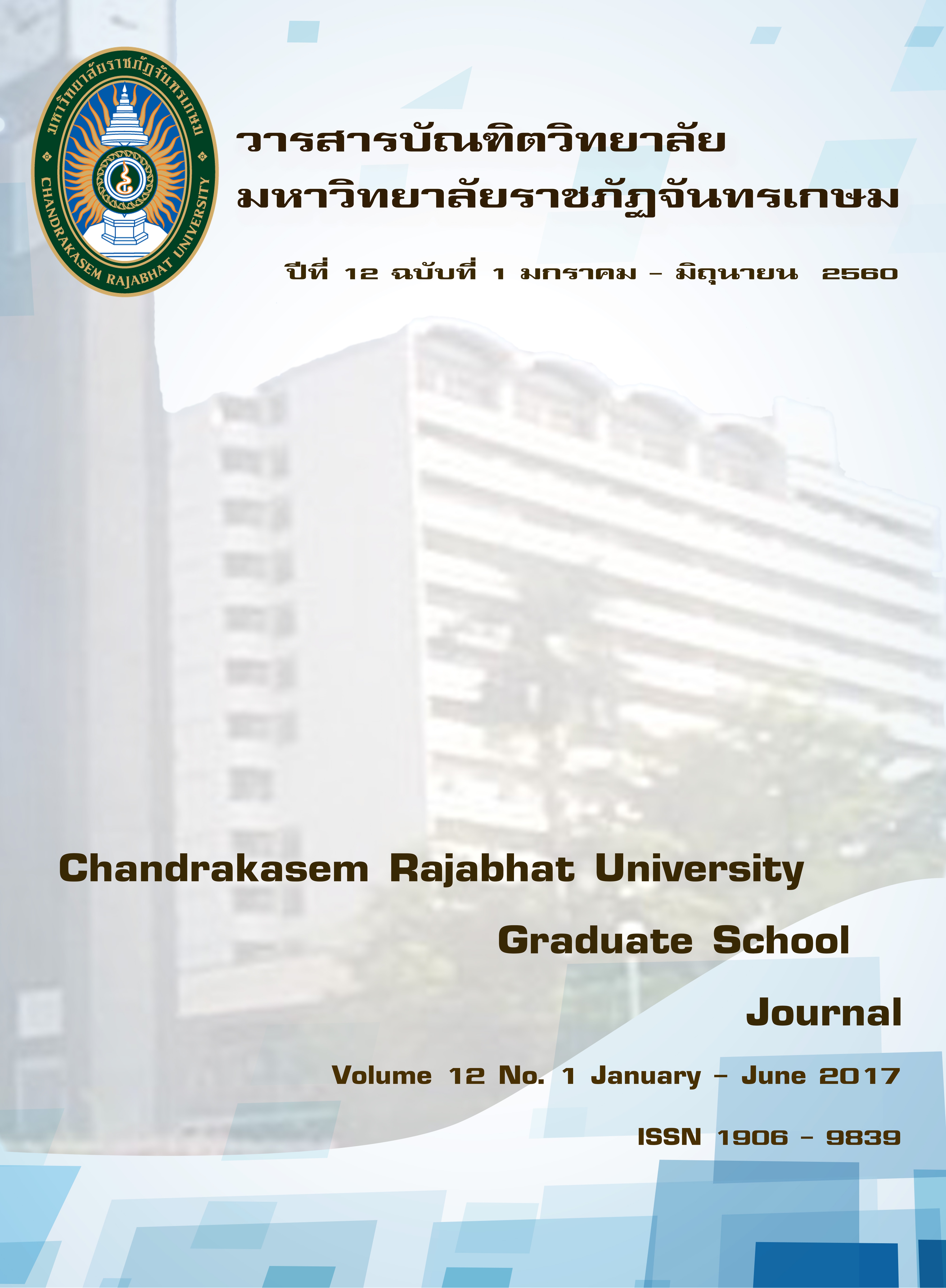พฤติกรรมและแรงจูงใจในการใช้งานสื่อสังคมออนไลน์ ของบุคลากรกรมประชาสัมพันธ์ ในกรุงเทพมหานคร
Main Article Content
บทคัดย่อ
การวิจัยครั้งนี้มีวัตถุประสงค์เพื่อ (1) ศึกษาพฤติกรรมในการใช้งานสื่อสังคมออนไลน์ ของบุคลากรกรมประชาสัมพันธ์ ในกรุงเทพมหานคร (2) ศึกษาแรงจูงใจในการใช้งานสื่อสังคม
ออนไลน์ของบุคลากรกรมประชาสัมพันธ์ ในกรุงเทพมหานคร (3) เปรียบเทียบพฤติกรรมในการใช้งานสื่อสังคมออนไลน์ของบุคลากรกรมประชาสัมพันธ์ในกรุงเทพมหานครจำแนก
ตามปัจจัยด้านประชากร (4) เปรียบเทียบแรงจูงใจในการใช้งานสื่อสังคมออนไลน์ของบุคลากรกรมประชาสัมพันธ์ในกรุงเทพมหานครจำแนกตามปัจจัยด้านประชากร และ (5) ศึกษาความสัมพันธ์ระหว่างพฤติกรรมและแรงจูงใจในการใช้งานสื่อสังคมออนไลน์ของบุคลากรกรมประชาสัมพันธ์ ในกรุงเทพมหานคร การวิจัยครั้งนี้เป็นการวิจัยเชิงสำรวจ กลุ่มตัวอย่างที่ใช้ในการวิจัย ได้แก่ ข้าราชการลูกจ้างประจำ พนักงานราชการ และลูกจ้างชั่วคราวจำนวน 300 คน โดยการสุ่มตัวอย่างแบบชั้นภูมิ เครื่องมือที่ใช้ในการวิจัย คือ แบบสอบถาม สถิติที่ใช้ในการวิเคราะห์ข้อมูล ประกอบด้วย ค่าร้อยละ ค่าเฉลี่ย ส่วนเบี่ยงเบนมาตรฐาน ค่าสัมประสิทธิ์สหสัมพันธ์ตามวิธีของเพียร์สัน การทดสอบค่าทีและการวิเคราะห์ความแปรปรวนทางเดียว และทดสอบรายคู่
ผลการวิจัยพบว่า (1) พฤติกรรมการใช้งานสื่อสังคมออนไลน์เพื่อการทำงานภายในองค์กร และการใช้งานส่วนตัวมีค่าเฉลี่ยอยู่ในระดับมาก ส่วนการทำงานภายนอกองค์กรมีค่าเฉลี่ยอยู่ในระดับปานกลาง (2) แรงจูงใจภายในและแรงจูงใจภายนอกในการใช้งานสื่อสังคมออนไลน์มีค่าเฉลี่ย อยู่ในระดับมาก (3) บุคลากรที่มีอายุและรายได้ที่ต่างกันมีพฤติกรรมการใช้งานสื่อสังคมออนไลน์เพื่อการทำงานภายในองค์กร การทำงานภายนอกองค์กร และการใช้งานส่วนตัวแตกต่างกัน และ (4) บุคลากรที่มีอายุและรายได้ที่แตกต่างกันมีแรงจูงใจภายในและแรงจูงใจภายนอกต่อการใช้งานสื่อสังคมออนไลน์แตกต่างกัน ที่ระดับความมีนัยสำคัญ 0.05 และ (5) พฤติกรรมการใช้งานสื่อสังคมออนไลน์เพื่อการทำงานภายในองค์กร การทำงานภายนอกองค์กร และการใช้งานส่วนตัวมีความสัมพันธ์กับแรงจูงใจภายในและแรงจูงใจภายนอกในการใช้งานสื่อสังคมออนไลน์ ที่ระดับความมีนัยสำคัญ 0.05
Article Details
เอกสารอ้างอิง
2. จารุวรรณ กิตตินราภรณ;. (2550). พฤติกรรมการเปeดรับการใช้ประโยชน์และความพึงพอใจจากการเปิดรับข้อมูลข่าวสารผ่านเครือข่ายอินเตอรฺเน็ต “เวิลด์ ไวด์ เว็บ” (World Wide Web: WWW) ของ นักศึกษามหาวิทยาลัยราชภัฏนครปฐม. (วิทยานิพนธ์ปริญญามหาบัณฑิต). กรุงเทพฯ: มหาวิทยาลัยธรรมศาสตร์.
3. ปณิชา นิติพรมงคล. (2554). พฤติกรรมการใช้เครือข่ายสังคมออนไลน์ของคนวัยทำงานในเขต กรุงเทพมหานคร. วิทยานิพนธ์ ปริญญามหาบัณฑิต. มหาวิทยาลัยศรีปทุม.
4. พรรณิการ์ พุุ่มจันทร์. (2558). “พฤติกรรมการใช้สื่อสังคมออนไลน์ของนักศึกษาแพทย์ระดับปรีคลินิกของคณะแพทยศาสตร์ศิริราชพยาบาล”.เวชบันทึกศิริราช, 8(1).
5. ยุทธ ไกยวรรณ์. (2548). วิธีวิจัยทางธุรกิจ. กรุงเทพฯ : ศูนย์สื่อเสริมกรุงเทพ.
6. สำนักงานพัฒนาธุรกรรมทางอิเล็กทรอนิกส์ (องค์การมหาชน) กระทราวงเทคโนโลยีสารสนเทศและการสื่อสาร. (2557). การสำรวจพฤติกรรมการใช์อินเทอร์เน็ต
ในประเทศไทย ปี 2557. กรุงเทพฯ : สำนักงานพัฒนาธุรกรรมทางอิเล็กทรอนิกส์ (องค์การมหาชน).
7. อธิพงศ์ แซ่ลี้. (2557). ความสัมพันธ์ระหว่าง พฤติกรรมการใช้สื่อกับแรงจูงใจในการใช้สื่อ เฟสบุ๊คของผู้ใช้งานเฟสบุ๊คในประเทศไทย. วิทยานิพนธ์ปริญญา
มหาบัณฑิต. มหาวิทยาลัยบูรพา.
8. เอมิกา เหมมินทร์. (2556). พฤติกรรมการใช้และความคิดเห็นเกี่่ยวกับผลที่ได้จากการใช้เครือข่ายสังคมออนไลน์ (Social Media) ของประชาชนในเขต
กรุงเทพมหานคร. วิทยานิพนธ์ปริญญามหาบัณฑิต สถาบันบัณฑิตพัฒนบริหารศาสตร์.
9. Best, J. W. (1977). Research in Education. (3rd ed). Englewood Cliffs, NJ: Prentice-Hall.


